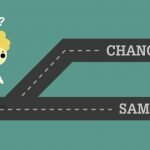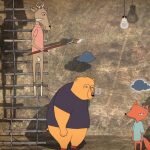Don’t Make a Journey Map, by Shahrzad Samadzadeh
 This is not an aspirational talk, or a formula to follow. It is a review of common journey map archetypes.
This is not an aspirational talk, or a formula to follow. It is a review of common journey map archetypes.
When Sha figured out that she could make a journey map based on needs and findings, she realized they could be really useful! However, after working on Adaptive Path’s guide to Experience mapping, she was hired to “make a journey map.” She was no longer a designer, just a journey mapper. Journey maps aren’t a good end goal, they’re a tool.
What’s a journey map?
A journey map is a visual representation of research that captures experience over time. At its core, it includes:
- Thinking
- Feeling
- Doing
- Touch points
- Environment
A journey map is grounded in phases over time (we’ll talk about this later).
Why make a journey map?
From a design perspective:
- Communicate research findings
- Address pain points
- Uncover opportunities to serve
- Identify existing strengths
- Build empathy, and challenge assumptions
From a business perspective:
- Tie potential actions to insights
- Increase conversion
- Plan customer communication
- Differentiate on experience
- Improve operational efficiency
What’s the problem?
There are many types of journey maps. Some are focused on products and services, others focused on users, others focused on the business.
- Product/service experiences
- It works because there’s a clear informational hierarchy, you can tell what’s important and what isn’t. It also provides a good amount of detail: not too much, not too little.
- Channels and touch points
- Good for marketing teams, very focused on the business. It focuses on communication channels and the touch points the customer experiences.
- Phases are specific to the business’s goal for the customer.
- It does make the next steps for a project obvious.
- Persona’s Narrative
- Builds empathy
- Only includes details relevant to the user
- UX Flow
- Primary focus is on how the interface and user interact
- Some people don’t think about these as journey maps, because they might be in spreadsheets or other non-map visuals.
- Important way to make sure we’re accounting for user goals and needs. It’s very focused on a small flow.
- Emotional Journey maps
- Focus is on the user’s emotions
- Phases are specific to emotional triggers and resolutions
- It’s a very lightweight map
- Blueprints
- Looks at front stage vs. back stage (what happens that the user sees, and what they don’t see)
- It focuses on one part of a service, and it emphasizes the number of technologies/players involved, so that teams don’t get silos
In short, journey maps are helpful when they deal with an understandable scope, focused story, and believable and grounded, grounded work.
Some problems with journey maps:
- Persona’s narrative can lead to scope creep
- Emotional journey maps can cause us to be unfocused
- Channels and touch point maps can be ungrounded and unfocused
- UX flows can be ungrounded
- Blueprints and Product/Service experiences can be all of the above
What can you do instead of a journey map?
- Have a workshop. Working through the process is more important than the end “map” or not-map deliverable
- Involving stakeholders helps clarify problems being solved
- Then they might create a journey map, based on the conversation
- A report, or taxonomy on behaviors
- An audit of all possible services
- A game
- For ideation, activities do more than maps
Guidelines for journey maps gone right
In order to not go wrong, just make sure to stay focused, grounded, and within the scope. These aren’t rules, but good guidelines.
- Focus
- Communicate critical information
- Have a message
- Don’t lose sight of the story
- Don’t add in things just because you can
- Remain grounded
- Stay connected to the research
- Focus on the project goals
- Don’t map in a silo – you’ll forget key players (workshops!)
- Scope
- Set goals
- Stay engaged with what’s feasible
- Set boundaries
Keep in mind 2 key questions:
- What do we intend to design for?
- What are we hoping to achieve?
This will help you focus, figure out the timeline, and stay in either current or future state – not both!
Each of the 6 common types of journey maps can be useful, but they’re specific to areas of focus, and key goals. There are endless combinations, however, hybrids and variations.
TL;DR Do not make journey maps just to make them!


